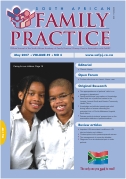Pretoria medical students’ perspectives on assessable attributes of Professionalism
Keywords:
Professionalism, Charter of Medical Professionalism, Teaching professionalism, Humanist attributes of medical professionalism, assessment of professionalism
Abstract
Background Professionalism forms an important aspect of medicine’s contract with society, and it is therefore important that it should be assessed and developed in medical schools. For the effective assessment of medical students’ professionalism, clear objectives, or outcomes based on a clear definition of professionalism, have to be accepted by society, the faculty and the students. A Physician’s Charter, ‘Medical Professionalism in the New Millennium, was published by the Annals of Internal Medicine in February 2002. Fifth-year medical students of the University of Pretoria were challenged to comment on the applicability of this Charter’s principles and responsibilities in the South African context. The majority of the students did not fully agree with the principles and responsibilities. A following cohort of fifth-year students was requested to define professionalism and describe attributes that could be included in an assessment tool. Methods A qualitative design was employed to explore the students’ perceptions. An analysis of the scripts was performed using qualitative content analysis. All the scripts were read twice and the emergent themes (attributes of professionalism) were identified by two researchers. The scripts were reviewed and coded independently to enhance reliability. Investigator triangulation, involving researchers with diverse research backgrounds, was done to validate the identified attributes. The themes were organised into categories (domains of professionalism). The authors discussed differing concepts with the other members of the Professional Attitude Development and Assessment Committee (PADAC) to arrive at a consensus. In the second stage of analysis, the identified themes were compared to the Charter. This was supported by quotations taken from the students’ perceptions, as well as from the relevant literature. Tabulations were used to determine the frequencies of the different themes. Results The attributes used to describe professionalism were grouped under four main domains: attitude and personal conduct, teamwork, patient care and professional competence. These correspond, to some extent, with the Charter. Most of the students, however, stressed the humanistic attributes of professional behaviour, which are not mentioned in the Charter. These attributes include empathy, interpersonal relationships, integrity, respect, maturity and teamwork. Conclusion The students’ perceptions of professionalism differed from that described in the Charter. The fact that the students value the humanistic part of professionalism could possibly be ascribed to the following factors: • Teaching of professionalism at the University of Pretoria focuses on the humanistic attributes, which form an important part of patient consultations and teamwork. • Medical students are not actively involved in the social contract that is prominent in the Charter. They have very little influence regarding social justice, access to care, distribution of resources and conflict of interest. • The Charter is considered vague and open to interpretation It is recommended that a universally acceptable charter be developed for the Medical School of Pretoria by involving faculty members to validate and accept the students’ perspectives. It is also recommended that these mutually accepted attributes then be used as the assessment criteria of a professionalism assessment tool. This should also encourage faculty members to act as good role models.
Published
2007-05-09
Issue
Section
Original Research
By submitting manuscripts to SAFP, authors of original articles are assigning copyright to the South African Academy of Family Physicians. Copyright of review articles are assigned to the Publisher, Medpharm Publications (Pty) Ltd, unless otherwise specified. Authors may use their own work after publication without written permission, provided they acknowledge the original source. Individuals and academic institutions may freely copy and distribute articles published in SAFP for educational and research purposes without obtaining permission.

